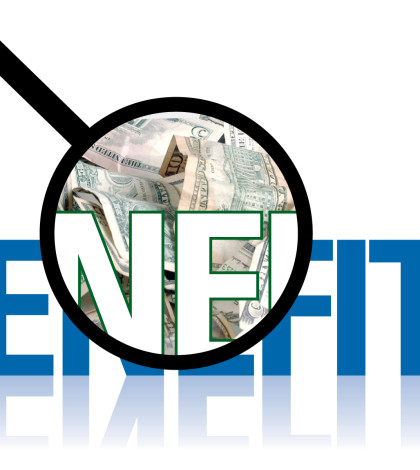Supplemental Benefits With Russ Goldner
August 3, 2020
Dear Valued Client,
I hope this letter finds you well. It has been a very interesting year to say the least. Times are ever evolving, but our goal at Saxon remains unchanged to ensure you have the best benefit experience possible. In working with over 600 groups, we find this comes in many forms and fashions.
The one aspect of benefits that Saxon has provided through direct to carrier relationships is the supplemental benefit arena. Supplemental benefits are plans many folks use to help offset the cost of a major medical procedure or the recent rise of deductibles. In response to the more frequent request for these plans, I am excited to announce Saxon has decided to step into this arena to assist our clients directly.
Russ Goldner has joined Saxon as our Director of Supplemental Benefits. With 15 years of experience in this discipline, Russ can assist in developing a supplemental benefits program that fits the needs of your company and, most importantly, the needs of your employees.
Supplemental benefits are an excellent means of complimenting your major benefit lines because they further enhance a benefit lineup assisting in both recruiting and retention. These lines are voluntary, allowing your employees to opt for coverage that is best for them and their families, especially in filling potential gaps in their deductible funding or costs of living while recovering from a medical malady.
Russ will be following up with you to further discuss the advantages of providing supplemental benefits to your employees. If you want to reach out to Russ prior to, he can be reached via email at rgoldner@gosaxon.com or via phone at (513) 317-8412.
Respectfully,
Jamie Charlton
Spotlight Value of Benefits Package During Open Enrollment
The COVID-19 pandemic has highlighted the importance of helping employees maintain physical, mental and financial health, making this year's open enrollment period a critical time for employers to think about the benefits they're providing and to communicate the value of these offerings to employees.
"This is not a typical year," said Hope Manion, senior vice president for Fidelity Investments' workplace consulting division. "We cannot simply default our benefits like we may have done in previous years."
She advises employers to encourage employees to spend more time during this year's enrollment period reviewing their benefits, learning about all of their offerings and asking questions. "Given that so many have experienced financial and health crises this year, now is the time to ensure they don't overlook benefits that could impact their future health and financial well-being," she noted.
Employees Rush Through Enrollment
Nearly three-quarters of employees—73 percent—spend less than an hour, and 41 percent invest less than 30 minutes, reviewing their benefits at enrollment time, according to a March study of 1,200 U.S. consumers on behalf of life and accident insurer Colonial Life. Because the pandemic has changed the way millions of workers live and work, simply rushing through their annual benefits enrollment won't do this year.
"If this year has taught us anything, it's the importance of our health and the value in taking every opportunity to protect it," said Richard Shaffer, senior vice president of field and market development at Colonial Life. "As we head into enrollment season this fall, workers across the country need to take time to ensure they're protecting their families, finances and futures against unexpected events."
Surprisingly, those who are the least confident in their knowledge of the benefits available to them are most likely to rush through the enrollment process. Nearly 90 percent of employees who reported not understanding their benefits "at all" said they plan to spend less than an hour on enrollment this year.
"Especially in today's environment, offering benefits isn't enough," Shaffer said. "To make the investment pay off, employers must ensure employees take the time to understand, value and participate in the benefits enrollment process."
Showcasing How Benefits Are Vital
A new Fidelity report, Uncovering the Real Value of the Benefits You Offer, shows that employees are often unaware of their benefits options and frequently don't take advantage of them. The findings are from a survey of nearly 9,500 participants in Fidelity-administered benefit plans.
For instance, only 61 percent of employees could report whether telemedicine was offered to them. "In this case, if you are offering a benefit low in awareness, you may need to go back to basics and increase promotional efforts that emphasize availability, what it is, and how to use it," the report points out.
Health saving accounts (HSAs) are a different story. While 92 percent of employees surveyed knew whether an HSA was available, many chose not to opt for a high-deductible health plan (HDHP), which is a requirement to contribute to an HSA. However, 89 percent of account-holders who used an HSA reported that it had a positive effect on their lives. "In this case, awareness about availability isn't the issue, but employees may not understand the value a benefit brings," the report stated.
Approaching Open Enrollment
Fidelity's Manion suggested that open enrollment communications encourage employees to consider the following when selecting benefits for the year ahead:
- Health insurance. Consider your finances, family health status, and preferred health care providers and hospitals when choosing health care coverage. Review deductibles and out-of-pocket maximums. To take advantage of an HSA, enroll in an HDHP.
- HSAs and flexible spending accounts (FSAs). Take the time to learn how each of these accounts can be used, reviewing eligibility guidelines and updates to coverage, including services like telemedicine and over-the-counter medications.
- Retirement savings. Consider increasing your 401(k) retirement savings plan contribution if the company reduced or suspended its match as a result of the COVID-19 pandemic.
Other benefits may not require an employee to enroll and so are often overlooked despite their value, Manion noted. Be sure to highlight information regarding:
- Telemedicine. Among Fidelity clients, 76 percent saw an increase in telemedicine use since the COVID-19 pandemic began. This benefit will continue to be important, and employees should understand how it works.
- Employee assistance programs (EAPs). As the pandemic caused many people to experience anxiety, mental health and counseling services, such as those offered through an EAP, saw a 39 percent increase in use. This is a benefit that is impactful to employees' overall well-being when offered.
- Wellness programs. Wellness programs are much appreciated when used, but 30 percent of employees surveyed did not know whether their employer offered them.
With millions of employees still working at home, effective benefits communication is more challenging than ever, Colonial Life's Schaffer said. He advised business and HR leaders to "ensure they're providing opportunities for employees to learn basic information and ask questions, even in a virtual environment."
|
5 Questions to Kick-Start Open Enrollment Planning For employees dealing with physical, emotional and economic setbacks due to the pandemic, "this will be the year to reevaluate insurance and financial safety nets, so keep this in mind as you communicate about medical plans, disability insurance, flexible spending accounts and other financial wellness benefits," blogged Megan Yost, vice president and engagement strategist at communications consultancy Segal Benz in San Francisco. She advised open enrollment managers to ask themselves five questions:
"Even if you don't have all your plan design changes finalized just yet, planning ahead can help make everything go more smoothly and minimize unnecessary stress," Yost observed. "Lay your foundation now—and fill in the details when you have them." SOURCE: Miller, S. (10 August 2020) "Spotlight Value of Benefits Package During Open Enrollment" (Web Blog Post). Retrieved from https://www.shrm.org/resourcesandtools/hr-topics/benefits/pages/spotlight-benefits-value-during-open-enrollment.aspx |
Actions on Payroll Taxes and Unemployment Benefits Promise Relief, Raise Questions
Due to the amount of job losses caused by the coronavirus, President Trump has signed a series of executive orders to provide financial relief. Read this blog post to learn more.
On Aug. 8, President Donald Trump signed a series of executive orders and memorandums intended to provide financial relief to employees and those who have lost their jobs due to the COVID-19 pandemic.
These declarations included a Memorandum on Deferring Payroll Tax Obligations in Light of the Ongoing COVID-19 Disaster, which directed the Treasury Department to defer collection of the employee portion of Social Security FICA taxes—part of required payroll tax withholding—from Sept. 1 through the end of 2020. The deferred taxes may have to be subsequently repaid unless Congress enacts legislation stating otherwise.
Trump cited his authority to postpone certain tax deadlines by reason of a presidentially declared disaster. Democrats, however, are expected to challenge that claim in court. Nevertheless, it is prudent for employers and payroll managers to stay aware of developments and prepare to move quickly if the directive and upcoming guidance are not blocked or superseded by enactment of a comprehensive relief bill.
Payroll tax relief, as outlined in the president's directive, would require employers to take steps to ensure compliance, including working with their payroll administrators to adjust their systems by Sept. 1. Employers would also need to explain to employees that while their take-home pay may go up in the short term, they may be required to repay these deferred taxes at a future date.
Details on employer requirements, however, would depend on Treasury Department guidance, expected to be issued shortly.
The other presidential actions authorized a weekly supplemental federal unemployment benefit of up to $400, reduced from the $600 weekly supplement that expired July 31; continued student loan payment relief; and called for measures to prevent residential evictions and foreclosures resulting from financial hardships due to COVID-19.
|
Reduced Unemployment Insurance Supplement Republicans in Congress argued that the initial $600 federal supplemental payment disincentivized recipients from seeking jobs, since many were collecting more money unemployed than employed. Some wanted the program reduced to $200 per week, while Democrats argued the program should be renewed at the original $600 per week. Questions were raised about funding for the $400 unemployment insurance boost, which would pull from FEMA's Disaster Relief Fund to pay for a portion of the supplemental benefits while asking states to fund the remainder. Because states may not use the unemployment program to pay benefits unless they are authorized by Congress, they may have to set up a new system to pay their portion of the supplement. Unemployment experts were also unsure about how funds will be distributed, who will qualify for benefits and how long the benefits will last, pending regulatory guidance. |
FICA Taxes
Social Security and Medicare payroll taxes are collected together as the Federal Insurance Contributions Act (FICA) tax. FICA tax rates are statutorily set and are not adjusted for inflation.
Social Security is financed by a 12.4 percent payroll tax on wages up to employees' taxable earnings cap—$137,700 for 2020—with half (6.2 percent) paid by workers and the other half paid by employers. There is no earnings cap on the Medicare portion of FICA, for which employers and employees separately pay a 1.45 percent wage tax.
The COVID-19-related payroll tax relief only applies to the Social Security portion of FICA.
The Payroll Tax Directive
Section 2302 of the Coronavirus Aid, Relief, and Economic Security (CARES) Act, enacted in March and implemented through IRS Notice 2020-22 and a series of IRS FAQs, allows eligible employers to defer the deposit and payment of the employer's share of Social Security FICA taxes for the period beginning March 27, 2020, through Dec. 31, 2020. The deferral also applies to 50 percent of the equivalent taxes incurred by self-employed persons. The deferred payments must subsequently be paid to the Treasury Department, with half due by Dec. 31, 2021, and the other half by Dec. 31, 2022.
The CARES Act provision and related guidance did not apply to employees' share of the Social Security tax.
Under the new presidential directive:
- The secretary of the treasury is authorized to defer the withholding, deposit and payment to the Treasury of employees' portion of Social Security payroll taxes on applicable wages or compensation paid from Sept. 1, 2020, through Dec. 31, 2020. This provision does not apply to the Medicare portion of FICA taxes.
- The deferral is to be made available to employees whose earnings during any biweekly pay period is generally less than $4,000, calculated on a pretax basis, which would cover salaried employees earning $104,000 or less per year.
- Social Security taxes for these employees will be deferred without any penalties, interest, additional amount or addition to the tax.
- The secretary of the treasury is directed to issue guidance to implement the president's memorandum and to explore avenues, including legislation, to eliminate the obligation to pay the taxes deferred under the implementation of the memorandum.
Josh Blackman, a constitutional law professor at the South Texas College of Law Houston, blogged that HR lawyers will have until Sept. 1 "to figure out the details." Because the policy terminates on Dec. 31, 2020, "President Trump, or President Biden, will be forced to decide whether to continue this program," he wrote.
A Controversial Move
"By providing this tax relief, American families will have more cash on hand during these critical next few months," according to a White House statement.
White House economic advisor Larry Kudlow said that "we will take any steps possible to forgive this deferral," so employees will not be required to pay back the amounts deferred through Dec. 31, The Hill reported. However, doing so would require new legislation by Congress.
Presumptive Democratic presidential nominee Joe Biden charged that Trump would try to make the cuts permanent if re-elected and said doing so would "undermine the entire financial footing of Social Security."
Prepare to Adjust Systems and Notify Employees
For now, HR payroll managers should:
- Discuss with their payroll administrators steps to adjust their payroll systems to exclude employees' share of FICA Social Security taxes beginning Sept. 1, pending the issuance of Treasury guidance.
- Prepare to notify employees that possibly less of their pay will be subject to payroll withholding, although the reduction in payroll taxes may have to be paid back in the future.
- Expect questions from employees who may be confused about current and future paycheck adjustments.
|
Employers' Questions Await Guidance The president's executive memorandum "leaves open a number of questions and issues, some of which will likely be addressed by guidance from Treasury," according to a legal alert by Adam Cohen, Mary Monahan and Robert Neis, partners at law firm Eversheds Sutherland in Washington, D.C. Issues to be addressed, they said, include:
A Wait and See Approach Melissa Ostrower and Robert Perry, principals in the New York City office of law firm Jackson Lewis, "recommend that employers continue to monitor applicable guidance, but not make any changes to their payroll withholding processes at this time." They added, "We realize that changes to payroll systems require lead time, but given the uncertainty surrounding how the deferral will be implemented and whether it actually will become effective, we think this is the most prudent course at this time." SOURCE: Miller, S. (10 August 2020) "Actions on Payroll Taxes and Unemployment Benefits Promise Relief, Raise Questions" (Web Blog Post). Retrieved from https://www.shrm.org/resourcesandtools/hr-topics/compensation/pages/actions-on-payroll-taxes-and-unemployment-benefits-promise-relief-raise-questions.aspx |
Benefits Consideration for Onboarding Furloughed and Laid Off Employees
As the COVID-19 pandemic continues to create obstacles for the workplace, many professionals are still having to continue with their day-to-day work lives which include having hard discussions with furloughed and laid-off employees. Read this blog post to learn helpful tips on re-enrolling employees into their benefits.
COVID-19 continues to throw us curveballs. While some states that were continuing on their path to recovery are having to backtrack, others have managed to temporarily halt the progression of COVID-19 and are proceeding as planned.
Amidst all this uncertainty, one thing is certain: human resource professionals continue to face overwhelming obstacles. Below, we outline issues that human resource professionals are likely to face as they onboard furloughed and laid-off employees.
Onboarding Furloughed Employees
HEALTH AND WELFARE PLANS
For employees enrolled in one or more employer sponsored health and welfare plans and receiving coverage during the furlough period:
- Payroll deductions for required employee contributions for the plan generally resume upon return from furlough, subject to any changes in employment status that may affect eligibility.
- To the extent repayment of employee contributions advanced during the furlough period is required, consider how to collect the employee contributions (e.g., through payroll deduction or otherwise), keeping in mind state law requirements related to payroll deductions.
- Consider the extent to which election changes may be made upon return from furlough.
For employees not enrolled in an employer-sponsored health and welfare plan during the furlough period (or enrolled in COBRA continuation coverage):
- Determine when eligibility for the plan resumes in accordance with plan terms (e.g., immediately or after a waiting period), subject to any impact on eligibility due to changes in employment status.
- Consider the process for enrolling employees and the extent to which election changes may be made upon return from furlough, including any HIPAA special enrollment rights.
In addition:
- Evaluate the impact of the furlough on employees' full-time status under the Affordable Care Act's (ACA's) lookback measurement period and stability period requirements.
- Evaluate the impact of return from furlough on participation in wellness program activities and eligibility for wellness program incentives.
- To the extent employees will have staggered work schedules, consider entitlement to benefits based on reduced hours (full time/part time) or new job requirements and whether any plan amendments are needed.
401(K) PLANS
Generally, employee and company contributions resume upon return from furlough; however, changes in job titles or positions may affect eligibility:
- Determine whether employee and company contributions will resume immediately upon return from furlough based on elections in place immediately before the furlough period or whether new elections will be required.
- Determine the extent to which legally required notices relating to plan participation must be provided.
- Address the treatment of loan repayments upon return from furlough.
- Determine the extent to which the period of furlough must be counted for purposes of plan eligibility, vesting and the right to allocation of contributions.
PENSION PLANS
- Consider whether changes in job titles or positions may affect eligibility for continued participation upon return from furlough.
- Review plan terms to determine the extent to which the period of furlough must be counted for purposes of plan eligibility, vesting and benefit accrual.
OTHER BENEFITS
- Consider the impact of return from furlough on any commuter benefits (parking and transit).
- Consider the impact of return from furlough on vacation and holiday accrual.
Onboarding Laid-Off Employees
HEALTH AND WELFARE PLANS
- Treat rehired employees who have been laid off as new hires who must complete new hire paperwork for health and welfare plan eligibility.
- Consider the impact of the termination of employment and rehire on the employee's status as a full-time employee under the ACA's lookback measurement period and stability period requirements.
QUALIFIED RETIREMENT PLANS
- Defer to plan terms and break-in-service rules for purposes of determining the impact of the layoff on plan eligibility, vesting and benefit accrual.
- Review plan terms and procedures for enrolling rehired employees in a 401(k) plan, including application of the plan's auto-enrollment feature, if any.
SOURCE: Pepper, T. (29 July 2020) "Benefits Consideration for Onboarding Furloughed and Laid Off Employees" (Web Blog Post). Retrieved from https://www.shrm.org/resourcesandtools/hr-topics/benefits/pages/benefits-consideration-for-onboarding-furloughed-and-laid-off-employees.aspx
Benefits fair cancelled? 6 strategies for remote benefits communication
Even as states begin to reopen from COVID-19-related closures and many employees return to their places of work, employers can’t rely on past approaches to communicate benefits information during open enrollment and to educate employees about their benefits. It’s unlikely that employers will be hosting large events like benefits fairs, a staple of open enrollment in past years, soon. In addition, some employees may continue to work remotely for an extended period, which means in-person benefits communication can’t be the only strategy.
Employers can consider several alternatives to craft an open enrollment and benefits education and engagement strategy that addresses these issues. For many employers, the solution will be to combine several of these approaches to ensure they are effectively communicating important benefits information and providing employees with more than one way to learn about their benefits and get answers to any questions that may arise.
Before developing a strategy, consider surveying employees to find out how they would prefer to receive information about benefits. Some people find email or printed materials effective, others prefer videos or interactive webinars, while others may be more responsive to receiving information via text message. Once you know your employees’ preferences, you can tailor your approach to increase the likelihood that your employees will use the tools you provide and have a positive experience.
- Recast your benefits fair as a virtual event. If you want to gather employees together and explain benefit options, how the open enrollment process will work this year and provide them with the opportunity to interact with benefit vendors, you could create a virtual event modelled on the in-person benefits fair. Depending on your organization’s size, the number of employees you need to reach, and where they are located (for example office employees, warehouse or field employees, and remote employees), your approach to hosting a virtual benefits fair will vary. A growing number of IT service vendors offer virtual event planning and execution services that include setting up the technology needed to conduct the event, handling invitations and registrations of participants, working with benefits vendors to set up virtual booths and arranging educational webinars as part of the event.
- Use your employee intranet, portal, or app. Regardless of whether you host a virtual event, you can use your employee website, portal or app and upload all the informational and educational material employees will need to make benefit choices. This approach can also include a secure portal that employees use to complete benefits forms. Another good feature to include is a chat, which can be either live chat or a chatbot, where employees can get answers to frequently asked questions and assistance with completing open enrollment forms.
- Host webinars. Webinars not only give you the ability to communicate information about benefits, they also give employees the chance to directly ask the HR and Benefits team questions. In addition to the live webinar, you can record the event and post it on your organization’s employee site or send a link via email so that employees who were not able to attend can still hear your message firsthand.
- Mail printed materials home. Some employees still prefer to receive benefits and enrollment information and forms in a printed format. It can provide a resource that they can easily refer back to when making their benefits sign up decision. Mailing these materials to employees’ home addresses rather than using your business address ensures that all employees, those who have returned onsite and those who are working remotely, have access to the information they need.
- Use texts and calendar reminders. To help employees stay on top of enrollment deadlines, send text messages and add reminders to their work calendars. Text messages can also be used to send links to more in depth information resources so employees can access information when required.
- One-on-one support is key. Employees are bound to have more complicated or confidential questions about their benefits choices, e.g. the need for information about coverage for cancer treatment or labor and delivery. Providing one-on-one phone and chat support from the HR and Benefits team gives employees a way to get answers to questions they don’t want to ask in a more public forum such as a webinar.
A benefits plan is only valuable if employees are knowledgeable about what benefits they have and how to access them. Many of these approaches can also be used on an ongoing basis to provide education on and drive engagement with benefits so employees and employers both get the most out of their plans.
SOURCE: Varn, M. (27 July 2020) "Benefits fair cancelled? 6 strategies for remote benefits communication" (Web Blog Post). Retrieved from https://www.benefitnews.com/opinion/benefits-fair-cancelled-6-strategies-for-remote-benefits-communication
‘It’s a fool’s choice’ when employers ignore investments in mental health benefits
Many employers have realized that the coronavirus pandemic has effected their employee's mental health tremendously. Many are now looking into opportunities to innovate change in the way mental health is viewed. Read this blog post to learn more.
As more states reopen and the return to work process gets underway, employers are grappling with how to address the rising mental health issues that have resulted from the COVID-19 pandemic.
The Society for Human Resource Management Foundation, One Mind at Work, and Psych Hub have partnered together to launch Mental Health and Wellness in the Workplace, an initiative to engage HR professionals in education and training opportunities to lead changes in the way mental health and wellness are viewed in the workplace.
“Our focus is on helping HR professionals and managers lead positive social change in the workforce,” says Wendi Safstrom, executive director of the SHRM Foundation. “We think it's critical to help employers and employees manage significant mental health tools related to COVID-19, and even beyond as companies begin to reopen.”
Mental health has been a growing concern among workers as the pandemic has worn on. About 41% of employees feel burnt out, drained, or exhausted from their work, according to data from SHRM. Additionally, nearly one in four employees report frequently feeling down, depressed, or hopeless — yet more than one in three employees reported having done nothing to cope with these feelings.
The SHRM Foundation, One Mind and Psych Hub initiative provides employers and HR professionals with a workplace wellness resource center, as well as training resources to help them address and improve mental health issues among employees.
The training covers topics like promoting workplace wellness, managing mental health during a crisis, and becoming an “agent of change” for workplace mental health.
Providing wide-spread education on mental health ensures that the diverse needs of employees have the opportunity to be met.
“What we're saying to everyone is that you cannot be autocratic here — this is about empathy,” says Garen Staglin, chairman of OneMind and co-founder of OneMind at Work. “You can't mandate that people are going to feel okay just because you tell them it's okay.”
Each member of the alliance brings a particular expertise in their respective practice areas. The SHRM Foundation focuses on workplace social change, One Mind at Work focuses on best practices and tools for brain health in the workplace, and Psych Hub focuses on multimedia learning solutions to mental health and addiction.
The materials are available to all companies and HR professionals via the Psychhub website. Employers, HR, and staff will have access to articles and other content on a variety of mental health subjects.
Investing in this program will not only help employees as they’re struggling now, but ensure investment into their future.
“We did a study that said for every dollar you invest in accelerating workplace best practices for mental health, you'll get a $3 to $5 return in the form of lower absenteeism, improved productivity, better customer service, and lower workers comp claims,” Staglin says. “It's a fool's choice to ignore brain health and workplace mental health, because the costs are extremely high.”
SOURCE: Schiavo, A. (23 July 2020) "‘It’s a fool’s choice’ when employers ignore investments in mental health benefits" (Web Blog Post). Retrieved from employeebenefitadviser.com/news/its-a-fools-choice-when-employers-ignore-invest-in-mental-health-benefits
Overview of COVID-19 Law and Guidance for Health and Welfare Plans
The business operations of many small and large companies have been significantly affected due to the coronavirus pandemic. During this time, health and benefit plans are also being affected. Read this blog post to learn more.
The COVID-19 pandemic has significantly affected the business operations of small and large employers alike. To mitigate the harm from the pandemic to employers, the government has enacted major legislation and issued numerous guidance in the past few months pertaining to COVID-19, including rules that address various aspects of employee benefits.
This article provides an overview of significant COVID-19 legislation and guidance related to employer-sponsored health and welfare benefit plans that has been enacted or issued to date.
Some of these changes are mandatory for group health plans. Other are optional. Employers should carefully review these rules to determine any compliance obligations as well as any opportunities to benefit their businesses and respective employees.
Mandated Coverage of COVID-19 Testing (Mandatory)
Effective March 18, 2020 and until the end of the national emergency period for COVID-19, the Families First Coronavirus Response Act (FFCRA) requires group health plans to cover:
- COVID-19 diagnostic testing.
- Certain items and services that result in an order for, or administration of, the testing.
Plans must provide this coverage without imposing any requirements for cost-sharing, prior authorization, or medical management.
CARES ACT
The Coronavirus Aid, Relief, and Economic Security Act (CARES Act), which was signed into law on March 27, 2020, amended the FFCRA's coverage mandate to:
- Expand the scope of COVID-19 diagnostic tests that must be covered.
- Include rules regarding the rate at which a plan must reimburse a health care provider for the mandated services.
- Require coverage of preventive services and vaccines for COVID-19 as of 15 days after such a service or vaccine is given an "A" or "B" rating in a recommendation by the U.S. Centers for Disease Control and Prevention (CDC) or U.S. Preventive Services Task Force.
ADDITIONAL GUIDANCE
On April 11, 2020, the FFCRA and CARES Act FAQs provided additional information about this COVID-19 mandate. Items included details on required coverage of COVID-19 antibody tests, rules regarding required disclosures of the new coverage to plan participants, and which items and services related to COVID-19 testing must be covered by a plan.
Continuation of Health Benefits During Certain Leaves of Absence (Mandatory)
The FFCRA also requires (with some exceptions) employers with fewer than 500 employees to provide certain paid sick leave and family and medical leave related to certain COVID-19 reasons, as follows:
- Paid sick leave. An applicable employer must provide two weeks of emergency paid sick leave (EPSL) to an employee who is unable to work (or telework) due to certain reasons related to COVID-19. Reasons include quarantining of an employee (due to a Federal, state or local order or advice from a health care provider) experiencing COVID-19 symptoms, caring for an individual who is quarantined, and caring for a child under age 18 whose school or child care provider is closed.
- Family and medical leave. The employer must also provide up to twelve weeks of expanded Family Medical and Leave Act (FMLA) leave (ten of which is paid) for an employee who has been employed for at least 30 days and who is unable to work (or telework) due to a bona fide need for leave to care for a child whose school or child care provider is closed or unavailable for reasons related to COVID-19.
During FMLA leave, an employer is required to allow the employee to continue his or her group health coverage at the same premium rate as that of active employees. The DOL has also issued FAQs stating that employers must continue employees' coverage during EPSL, as well. Note, there are also implications for retirement plans under the FFCRA and CARES Act. Although those retirement plan rules are not discussed in this article, some of the CARES Act rules are conceptually similar for retirement plans (e.g., 401(k) plans may allow participants to take "Coronavirus-related" 401(k) plan distributions due to certain COVID-19 reasons).
High-Deductible Health Plans and Health Savings Accounts (Optional)
IRS GUIDANCE
IRS Notice 2020-15 (March 11, 2020), which was issued prior to passage of the FFCRA and CARES Act, provided that a high-deductible health plan (HDHP) will not lose its HDHP status if it covers COVID-19 testing and treatment before the statutory minimum HDHP deductible is met. Therefore, the plan can cover those COVID-19 related services without causing participants to be ineligible to contribute to a health savings account (HSA). IRS Notice 2020-29 (May 12, 2020) clarified that the provisions in Notice 2020-15 apply to an HDHP's reimbursement of expenses incurred on and after January 1, 2020.
CARES ACT
The CARES Act amended the HSA rules to provide that, for plan years before December 31, 2021, an HDHP does not lose its HSA-eligible status if it covers telehealth and other remote healthcare services before the HDHP deductible is met. This CARES Act provision is broader than the IRS Notices, as it provides that an HDHP can cover telehealth services regardless of whether the services are related to COVID-19. The CARES Act also allows participants to use their HSAs, health flexible spending accounts (FSAs), and health reimbursement arrangements (HRAs) to pay for certain over-the-counter drugs without a prescription as well as certain menstrual care products.
Extended Form 5500 Filing Deadline for Certain Plans (Optional)
IRS Notice 2020-23 (April 9, 2020) extended certain deadlines for a plan to file the required annual Form 5500. Under Notice 2020-23, the Form 5500 deadline was extended to July 15, 2020 for any plan whose plan year ended in September, October, or November 2019 (or any plan that was given a filing extension between April 1 and July 15, 2020). Ordinarily, a plan must file its Form 5500 (absent an extension) by the last day of the seventh month following the end of the plan year.
Relief for Certain Disclosures Required by ERISA (Optional)
EBSA Disaster Relief Notice 2020-01, which was issued by the DOL on April 28, 2020, extended the deadlines for plans to provide certain notices and disclosures under Title I of the Employee Retirement Income Security Act of 1974 (ERISA). Under Notice 2020-01, a plan will not be treated as violating ERISA if it fails to timely furnish a notice, disclosure, or document required by Title I of ERISA between March 1, 2020 and 60 days after the announced end of the national emergency declaration for COVID-19. The plan fiduciary, however, must act in good faith to furnish the notice, disclosure, or document as soon as administratively practicable. For this purpose, a plan fiduciary can meet the "good faith" standard by furnishing a document electronically if it reasonably believes that the recipient has access to electronic communication.
Extensions of Certain Plan Deadlines (Mandatory)
A joint notice issued by the DOL and IRS (published May 4, 2020) required group health plans to extend certain timeframes for participants during the "outbreak period" (defined as the period from March 1, 2020 until 60 days after the announced end of the national emergency for COVID-19). Those plans are required to disregard the outbreak period for purposes of determining the following periods and dates:
- The 30-day/60-day special enrollment period under the Health Insurance Portability and Accountability Act (HIPAA).
- The 60-day deadline for a qualified beneficiary to elect continuation coverage under the Consolidated Omnibus Budget Reconciliation Act of 1985 (COBRA).
- The deadlines for a COBRA qualified beneficiary to pay his or her required COBRA premiums.
- The deadline for an individual to notify the plan of COBRA certain qualifying events (e.g., divorce).
- The deadlines for a participant to file benefit claims, appeals, and external review requests with the plan (or to perfect an external review request).
Because of this joint notice, a group health plan must essentially "pause" the above deadlines during the outbreak period. For example, if an individual experienced a COBRA qualifying event on March 1, 2020, the individual would have until 60 days after the end of the outbreak period (rather than 60 days after March 1) to elect COBRA coverage. This is because the joint notice requires a group health plan to pause the 60-day timeframe for COBRA elections during the outbreak period. Also, because the joint notice was issued on May 4 and is retroactive to March 1, plans may be required to re-process previous claim denials that were based on a participant's failure to meet one of the above deadlines between March 1 and May 4.
Cafeteria Plans and Flexible Spending Accounts (Optional)
2020 MIDYEAR ELECTION CHANGES
IRS Notice 2020-29 (May 12, 2020) relaxed the rules regarding cafeteria plan pre-tax elections in light of the COVID-19 pandemic. Under Notice 2020-20, employers may (but are not required to) amend their cafeteria plans to allow participants to make the following mid-year, pre-tax election changes in 2020:
- An election to enroll in the health plan by an eligible employee who previously declined coverage (e.g., someone who waived coverage during open enrollment).
- An election to change plan options (e.g., from an HMO to a PPO) or add dependents.
- An election to drop coverage by a participant.
- An election to enroll in or drop health FSA or dependent care FSA coverage or to increase or decrease health FSA or dependent care FSA contributions.
An employer that wishes to adopt any of all of the above cafeteria plan changes must disclose the changes to employees and amend its cafeteria plan by no later than Dec. 31, 2020 (i.e., an amendment is not required in advance of making the changes).
EXTENDED GRACE PERIOD TO INCUR FSA CLAIMS AND INCREASE OF MAXIMUM HEALTH FSA CARRYOVER AMOUNT
Notice 2020-29 also permits employers to amend their health and dependent care FSAs to allow employees to incur eligible claims through the end of the 2020 calendar year for any FSA plan year (or for any FSA grace period that ends in 2020). For example, if a health FSA has a grace period until March 15, 2020 for a participant to incur eligible claims for the 2019 plan year, the FSA can allow participants to incur expenses through 2020 and use their 2019 elections to pay for those expenses.
This change does not apply to FSAs with a carryover provision. IRS Notice 2020-33 (May 14, 2020), however, provides for a permanent FSA carryover increase based upon annual indexing. For the 2020 plan year, employers may amend a cafeteria plan with carryover provision to allow participants to carry over up to $550 in unused health account balances in the 2021 plan year. An employer that adopts the extended FSA grace periods or the increased carryover limit must amend its cafeteria plan or FSA (as applicable) by no later than December 31, 2021.
Tax-Free Payment of Employees' Student Loans (Optional)
The CARES Act amended Section 127 of the Internal Revenue Code (education assistance programs) to permit employers to pay up to $5,250 of an employee's student loans on a tax-free basis. This provision applies from the date of enactment of the CARES Act (March 27, 2020) through the end of 2020. The payment must be for either the principal or interest of a qualifying education loan incurred by the employee, and the employer can make payment either directly to the lender or as a reimbursement to the employee.
Takeaways for Employers
As employers grapple with the impact of the COVID-19 pandemic and return to normal business operations, it is important for them to be aware of their compliance obligations under the FFCRA, CARES Act and other guidance issued by governmental agencies. Employers should also carefully review the guidance and legislation for potential avenues of benefit for their business and employees.
Additional guidance for both mandatory and optional items is likely forthcoming as well, and COVID-19 continues to have a major impact on both companies and individuals as new infections spike in numerous states. Accordingly, employers would be well-advised to keep a close eye out for new legislation and guidance in the coming months and periodically evaluate their benefits programs for compliance and competitive considerations.
SOURCE Tyler Hall, A.; Schillinger, E. (16 July 2020) "Overview of COVID-19 Law and Guidance for Health and Welfare Plans" (Web Blog Post). Retrieved from https://www.shrm.org/resourcesandtools/hr-topics/benefits/pages/overview-of-covid-19-legislation-and-guidance-for-benefits-plans.aspx
The Saxon Advisor - July 2020
Compliance Check
what you need to know
SF HSCO Expenditures. The last day to submit SF HSCO expenditures, if applicable*, for Q2 is July 30, 2020. *Applicable for employers with 20+ employees doing business in SF and Non-Profits with 50+ employees.
Form 5500 and Form 5558. The deadline for the 2019 plan year’s Form 5500 and Form 5558 is July 31, 2020 (unless otherwise extended by Form 5558 or automatically with an extended corporate income tax return).
Form 8955-SSA. Unless extended by Form 5558, Form 8955-SSA and the terminated vested participant statements for the plan year of 2019 are due July 31, 2020.
Form 5558. Unless there is an automatic extension due to corporate income tax returns, a single Form 5558 and 8955-SSA is due by 2½ months for the 2019 plan year.
Form 5330. For failed ADP/ACP tests regarding excise tax, Form 5330 must be filed by July 31, 2020.
401(k) Plans. For ADP/ACP testing, the recommended Interim is due August 1, 2020.
In this Issue
- Upcoming Compliance Deadlines:
- Eligible Automatic Contribution Arrangement (EACA)
- The deadline for the 2019 plan year’s Form 5500 and Form 5558 is July 31, 2020.
-
Medicare 101: A Quick Guide For Employers
- Fresh Brew Featuring Saxon’s Holiday Favorites
- This month’s Saxon U: The Steps Of An Internal Investigation
- #CommunityStrong: Pick your Own Charity! One of our Own, Deborah Raines, made a meal for a family in need at her temple!
COVID and the ADA and EEOC
Join us for this interactive and educational Saxon U seminar with Pandy Pridemore, The Human Resources USA, LLC, as we discuss COVID and the Americans with Disabilities Act (ADA) and Equal Employment Opportunity Commission (EEOC).
Medicare 101: A Quick Guide For Employers
Bringing the knowledge of our in-house advisors right to you...
Medicare is a government-funded health insurance program for those aged 65 and above, those under 65 with certain disabilities, and those with End State Renal Disease (ESRD) or Amyotrophic Lateral Sclerosis (ALS). Employers that offer group health insurance plans to their employees have an interest in learning how employees’ entitlement to Medicare benefits can affect the administration of those plans.
“Ask a licensed agent for assistance. Advertisements can be confusing, and everyone wants to make the right choice. Using my expertise, I take the fear out of the decision making, so my clients can make an informed decision concerning their healthcare.”
Fresh Brew Featuring Saxon's Holiday Favorites
In celebration of Independence Day this past month, the Saxon crew has decided to share one of our favorite summer recipes for this month’s Fresh Brew! We hope you all have a safe and happy holiday!
This Month's #CommunityStrong:Each member of Saxon will be choosing their own charity that they want to make a positive impact on!
This May, June & July, the Saxon team and their families will be choosing their own charity that they would like to make a positive impact towards!
Are you prepared for retirement?
Saxon creates strategies that are built around you and your vision for the future. The key is to take the first step of reaching out to a professional and then let us guide you along the path to a confident future.
Monthly compliance alerts, educational articles and events
- courtesy of Saxon Financial Advisors.

How COVID-19 could be a financial wellness springboard
Although the coronavirus pandemic has brought many implications to watch during these times, health isn't the only thing. Many businesses could use COVID-19 as a way to monitor their financial wellness. Read this blog post to learn more.
Physical health isn’t the only thing to monitor during the COVID-19 pandemic, according to recent studies, which suggest the fate of businesses could depend on an ability to use financial wellness initiatives to restructure their financial and cultural mindset.
But what is financial wellness, and what can businesses do to cultivate it?
To enjoy financial wellness is to have control over daily and monthly finances, be able to meet financial goals, have enough rainy day money to survive an emergency and be able to splurge a little, according to the Consumer Financial Protection Bureau.
Of course, at this stage in the COVID-19 crisis, it’s all about step one — staying afloat day-to-day — according to Neil Lloyd, who heads Mercer’s US DC and financial wellness research.
But as the workforce gradually returns, there’ll be opportunities for major reinvention, the way Lloyd sees it.
“I think this is a time when you can look back at your benefits and say, ‘Well, given what we just learned, is there a better way to structure benefits that meet the needs of people?’ ” Lloyd said. “Because this is going to be in people’s minds. They’re not going to forget it in six months’ time.”
For some organizations, that might mean introducing an emergency savings account option to cover unexpected events, or providing tools that help staff understand and build their credit scores — widely expected to take a tumble in the coming months.
Why bother with financial wellness?
Even before COVID-19, 67% of employees reported feeling personally stressed, according to PwC’s 2019 employee financial wellness survey, which found 57% had less than $1,000 in emergency savings and 49% struggled to meet their financial obligations each month.
Those kinds of money worries are a bane for productivity, morale and turnover, according to the Retirement Advisor Council, which says the best way to reduce stress in the workforce is to tackle employee’s financial problems at their source.
Likewise, Mercer’s 2020 global talent trends survey of 7,300 senior business executives, HR leaders and employees across nine industries concluded that economics and empathy can and should coexist.
Though an organization’s ability to survive and expand depends on the talent and engagement of its workforce, Mercer found 63% feel at risk of burnout. And though 78% of employees said they want long-term financial planning, only 23% of companies said they provide it.
That means COVID-19 and its aftermath could present an opportunity for human resources departments to step up.
“Employers are also going to have a lot on their minds, so it’s going to be quite tough,” Lloyd said. “But ideally, try and see what you can learn from what we’ve just been through. What were all those stresses and strains that your people had? Maybe survey them and talk to them. Learn from this.”
Financial wellness initiatives only became popular about five years ago, according to Lloyd, who said Mercer’s latest survey suggests a change in the winds. While executives used to focus on the financial returns for each initiative, Lloyd says they’re developing a new understanding that, “If you look after your people well, they will ultimately look after you.”
“When we were talking to clients, what tended to happen quite quickly was, ‘Let me see the return on investment for financial wellness.’ I.e., ‘I put a dollar in here, what do I get back?’ Lloyd said. “People are beginning to not look at it like that.”
How to increase financial wellness
There’s plenty of room for financial wellness initiatives in 2020, according to Mercer, as its survey revealed only 29% of HR leaders have a health and wellbeing strategy in place, even though 61% of employees said they trusted their employer to look after their wellbeing and 48% of executives labeled it a top concern.
Offerings could range from group training sessions or one-on-one consultations to online resources or classes aimed at helping employees budget, save and manage debt, or even buy their first home. They might also help establish emergency funds, automatically enroll staff in retirement plans and open benefits up to all family members.
Mission: Money outlines six steps to establishing a financial wellness program — starting with deciphering the root causes of money woes. For some, it might be credit card or student loan debt, while for others it could be health care or retirement plan savings.
That information, coupled with an organization’s business objectives, is what employers should base their offerings on.
Above all, Lloyd says every initiative should build financial confidence, as opposed to unwittingly tearing it down. That means placing less emphasis on where an employee started and more on celebrating what they’ve achieved.
“It doesn’t help to say to somebody, ‘We did a financial literacy test and you scored 35%,’ when everybody knows 35% is bad. That can actually make somebody feel a lot worse about things,” Lloyd said. “Avoid getting into that situation where people think they’re a failure and want to avoid this topic. Rather, ensure that whatever we do in the financial wellness side is empowering and makes people more confident to keep on engaging with financial issues.”
Crucially, as employee needs, business objectives and markets change, so should financial wellness strategies. “Financial wellness is not something we’ve had 30, 40 years of success with, so you have to be prepared to try something new,” Lloyd said. “There’s a very good chance something’s not going to work, and you change it. That’s the process.”
SOURCE: Lean, R. (30 April 2020) "How COVID-19 could be a financial wellness springboard" (Web Blog Post). Retrieved from https://www.benefitspro.com/2020/04/30/how-covid-19-could-be-a-financial-wellness-springboard/
The Saxon Advisor - May 2020
Compliance Check
what you need to know
Eligible Automatic Contribution Arrangement (EACA). For failed ADP/ACP tests, corrective distributions must be made towards participants within 6 months after the plan year ends – June 30, 2020.
SF HSCO Expenditures. The last day to submit SF HSCO expenditures, if applicable*, for Q2 is July 30, 2020. *Applicable for employers with 20+ employees doing business in SF and Non-Profits with 50+ employees.
Form 5500 and Form 5558. The deadline for the 2019 plan year’s Form 5500 and Form 5558 is July 31, 2020 (unless otherwise extended by Form 5558 or automatically with an extended corporate income tax return).
Form 8955-SSA. Unless extended by Form 5558, Form 8955-SSA and the terminated vested participant statements for the plan year of 2019 are due July 31, 2020.
Form 5558. Unless there is an automatic extension due to corporate income tax returns, a single Form 5558 and 8955-SSA is due by 2½ months for the 2019 plan year.
Form 5330. For failed ADP/ACP tests regarding excise tax, Form 5330 must be filed by July 31, 2020.
401(k) Plans. For ADP/ACP testing, the recommended Interim is due August 1, 2020.
In this Issue
- Upcoming Compliance Deadlines:
- Eligible Automatic Contribution Arrangement (EACA)
- The deadline for the 2019 plan year’s Form 5500 and Form 5558 is July 31, 2020.
- Providing an HSA, FSA, or HRA Health Plan for your Employees
- Fresh Brew Featuring Lexi Kofron
- This month’s Saxon U: How To Legally Work With Gig And Contract Workers
- #CommunityStrong: Families Forward Donation Drive
How To Legally Work With Gig And Contract Workers
Join us for this interactive and educational Saxon U seminar with Pandy Pridemore, The Human Resources USA, LLC, as we discuss how to legally work with Gig and Contract Workers.
Providing an HSA, FSA, or HRA Health Plan for your Employees
Bringing the knowledge of our in-house advisors right to you...
When open enrollment hits annually, it is not uncommon for employers to feel exasperated when staring down a list of acronyms such as HSA, FSA and HRA. As it should go without saying, the most common first thought is, “What does any of this mean?” Even the most seasoned experts have difficulty with understanding the complexities of various care options.
““It is your account; yours if you leave the employer and can contribute as long as you have an HDHP and can use the funds until they are gone, even if you are no longer in an HDHP.” said Kelley Bell, a Group Health Benefits Consultant at Saxon Financial.
Fresh Brew Featuring Lexi Kofron
"Stay calm and collected on phone calls, and stay organized!"
This month’s Fresh Brew features Lexi Kofron, a Client Service Specialist at Saxon.
Lexi’s favorite brew is a Cinnamon Dolce Latte. Her favorite local spot to grab his favorite brew is at Starbucks
Scott’s favorite snack to enjoy is Pretzels and Hummus.
This Month's #CommunityStrong:
Families Forward Donation Drive
This May the Saxon family donated a bunch of household items and outdoor activities to Families Forward. Their staff goes out each week in masks and gloves to hand out these donations to the families in need through their program. Here are some pictures they provided when they passed out the donations and our trunk load of donations!
Are you prepared for retirement?
Saxon creates strategies that are built around you and your vision for the future. The key is to take the first step of reaching out to a professional and then let us guide you along the path to a confident future.
Monthly compliance alerts, educational articles and events
- courtesy of Saxon Financial Advisors.











